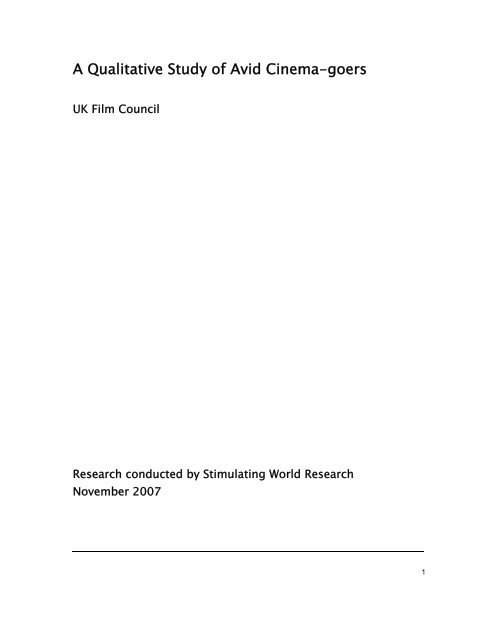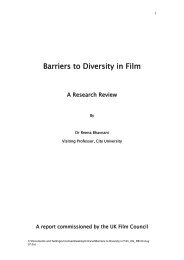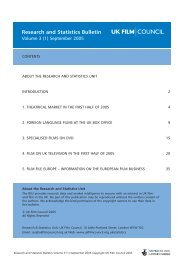Film Buffs - BFI - British Film Institute
Film Buffs - BFI - British Film Institute
Film Buffs - BFI - British Film Institute
You also want an ePaper? Increase the reach of your titles
YUMPU automatically turns print PDFs into web optimized ePapers that Google loves.
A Qualitative Study of Avid Cinema-goers<br />
UK <strong>Film</strong> Council<br />
Research conducted by Stimulating World Research<br />
November 2007<br />
1
Contents<br />
Executive Summary ......................................................................................... 3<br />
Introduction.................................................................................................... 7<br />
Methods ......................................................................................................... 8<br />
Results.......................................................................................................... 12<br />
Conclusion.................................................................................................... 25<br />
Appendices................................................................................................... 28<br />
2
Executive summary<br />
Background<br />
The research aimed:<br />
to build a detailed picture of what an avid (avid cinema-goer and consumer<br />
of film, previously ‘film buff’) is and the factors that help create them;<br />
to draw on avids experiences to provide insights into the cultural value of<br />
film.<br />
The fieldwork was conducted in two stages, involving interviews and focus<br />
group discussions with people that met strict selection criteria (based on their<br />
film viewing habits and age, gender & location).<br />
Defining avids<br />
Avids identities are bound up in film. It is who they are: a constant that<br />
frames and informs their perception of themselves and the wider world.<br />
Avids often use the word ‘obsession’ to describe their relationship with film.<br />
While they still find entertainment value in films, their engagement goes<br />
beyond this.<br />
For avids, cinema offers more than stories told in light and sound, seen once<br />
and soon forgotten. <strong>Film</strong>s offer the pre-eminent way of seeing and<br />
interpreting the world.<br />
Avids are very frequent cinemagoers and regularly attend film festivals and<br />
seasons.<br />
They are drawn to independent cinemas and film is central to their social life.<br />
Avids have a collector mentality and spend a great deal of time reading up on<br />
film and hunting for hard to get titles.<br />
They follow particular directors and take an interest in those parts of the<br />
world featured in their favourite films.<br />
It is common for avids to cite a particular film as the formative influence on<br />
their development. Often the film in question is said to have ‘really moved<br />
them’, caused them great excitement (‘it blew me away’) or provided a<br />
powerful point of identification (’that is me’). However, their initial<br />
introduction to film is usually through a cinema viewing of a mainstream title.<br />
3
Types of avids<br />
There are sub-divisions within the broad audience group ‘avids’. Three types<br />
of avids are discernible: summits, specialists and scatterguns.<br />
Summit avids are the most widely knowledgeable and tend to work in the film<br />
industry or film education/journalism. They are often interested in the<br />
business of film and may regard Hollywood as an interesting cultural<br />
phenomenon worthy of study.<br />
Specialist avids tend to be the most obsessive, often dismissive of films they<br />
do not deem worthy of consideration and they have a pronounced collector<br />
mentality.<br />
Scattergun avids enjoy film as one (albeit important) component of their<br />
varied cultural diet.<br />
The best way to encourage more summit avids is to promote career<br />
opportunities in the film business. Specialist avids need early nurturing,<br />
through film clubs for young people, discounted film<br />
admissions/merchandise etc. Because of their eclectic tastes and willingness<br />
to sample, scattergun avids are popular targets for marketers. Therefore<br />
promotion and marketing campaigns need to be mounted in the places they<br />
like to frequent: bookstores, art galleries, music festivals and bars. Efforts<br />
should be made to re-connect them with their love of film when other<br />
influences are at the fore.<br />
The film journey<br />
The journey to becoming passionate about film can be broken into a number<br />
of stages, equivalent to different levels of engagement with film.<br />
This is referred to as ‘the film journey’ and comprises the following stages:<br />
film as entertainment, film as identity, film as culture and film as career.<br />
The youngest audiences approach ‘film as entertainment’. Between the ages<br />
of four and eleven mainstream films (e.g. Star Wars, Grease) tend to be<br />
central in promoting interest in cinema.<br />
During teenage years film can become entwined with identity formation,<br />
helping to define ‘who I am’ (‘film as identity’) This is the age when people<br />
start to actively look beyond mainstream film choices.<br />
The key trigger that helps make people take this step is the trusted opinion<br />
former: family members, friends, film clubs, inspirational teachers and<br />
cultural icons.<br />
4
In early adulthood people may begin to conceive of ‘film as culture’.<br />
At this stage people start to look beneath the surface of film and subject it to<br />
critical analysis. They begin to look for films that offer an alternative to the<br />
mainstream and to move out of their comfort zone. It is often a key<br />
‘milestone movie’ that prompts a move into this stage.<br />
‘<strong>Film</strong> as career’ is the stage where people move into the film industry<br />
(including working in film education and journalism). It tends to be ‘a dream<br />
come true’ and something people have strived and worked hard for.<br />
The value of film<br />
The research identified a number of elements that combine to form the<br />
unique selling point for film (it is the combination of these elements that<br />
stands film apart from, for example, literature, music or the visual arts):<br />
<strong>Film</strong> can be informative and reveal essential truths about the human<br />
condition; it has immediacy and when viewed at the cinema provides an<br />
immersive experience; it is accessible; it is a widely shared cultural<br />
experience; and it is a doorway to other cultural spheres.<br />
Closely allied to these attributes is the value that film brings to people’s lives.<br />
The fieldwork suggests this value has personal and social/community<br />
dimensions.<br />
On a personal level film enables people to escape their worldly cares, it gives<br />
inspiration, helps people through their rites of passage, supports identity<br />
building, provides knowledge and promotes understanding in an accessible<br />
way, and (not least) gives considerable enjoyment.<br />
On a social/community level film can be the common thread that binds us<br />
into wider networks (“we all watch films and it gives us something to<br />
discuss”). <strong>Film</strong> is also felt to encourage tolerance and promote understanding<br />
of other peoples, cultures and ways of life.<br />
Above all, film is considered to have a unique cultural value because it is a<br />
remarkably accessible, inclusive and universal medium, with its appeal<br />
spanning generations and crossing national and linguistic boundaries (to a<br />
certain extent this also applies to television, but that tends to be perceived as<br />
a more mundane and parochial cultural form).<br />
Because of the powerful effect of stories told in light and sound (which<br />
connect with us via our dominant senses of sight and hearing), film is able to<br />
confront people with the real world whilst also speaking to their<br />
5
imaginations.<br />
Possible interventions<br />
To help people progress through the film journey:<br />
<strong>Film</strong> as identity<br />
Promotion of niche/alternative films on television;<br />
Foreground themes of sex, violence and horror (‘hooks’) as a way into<br />
subtitled films;<br />
Offer cinema admissions concessions for younger audiences and support the<br />
development of school film clubs.<br />
<strong>Film</strong> as culture<br />
Promote the Internet as a research tool;<br />
Support film societies, particularly in formal education contexts (schools, FE<br />
and HE institutions);<br />
Provide forums to meet actors, writers and directors;<br />
Provide and promote access to specialised films (e.g. through the Digital<br />
Screen Network).<br />
<strong>Film</strong> as career<br />
Better communicate the range of career opportunities in film;<br />
Cross promote film through other academic subjects;<br />
Provide more opportunities for enthusiasts to meet industry insiders (e.g.<br />
Q&As, workshops etc.).<br />
To harness the power of formative years:<br />
Encourage parents and educators to foster an interest in film among young<br />
people.<br />
<strong>Film</strong> offers fantastic benefits for young people. Are parents and others aware<br />
of this? Just as parents are encouraged to help children read and expand their<br />
minds what about the role of film?<br />
Encourage young people into the cinema – for the experience just as much as<br />
the actual film.<br />
As part of this, vibrant film societies at school and universities are essential.<br />
By their very nature young people are cash poor. Deals of any kind on film<br />
entrance and related merchandise would help encourage them to consume.<br />
To promote viewing opportunities:<br />
6
For many, seeing films on TV first fostered a love of film. Seasons of black<br />
and white movies were often cited.<br />
Are there enough important films being shown on free to air services and in a<br />
way that is accessible?<br />
Late night can suggest ‘illicit’ and ‘my world’ for teens and young adults- are<br />
there enough adult oriented film seasons that would appeal to aspirant<br />
youngsters?<br />
People living in the suburbs can crave cinemas that show ‘intelligent film’.<br />
The digital screen network should address this, along with support for<br />
community based film society activity.<br />
7
1 Introduction<br />
The UK <strong>Film</strong> Council’s Distribution and Exhibition Department has two primary<br />
functions; to help ensure that UK cinema audiences have access to the widest<br />
possible range of films at cinemas UK wide and to encourage audiences to<br />
increase their propensity to view less mainstream films. In order to help achieve<br />
these objectives it has two major funding tools: the P&A Fund which helps<br />
distributors widen their release plans and solidify their marketing efforts; and,<br />
the Digital Screen Network which is designed to harness new technology to<br />
reduce some of the financial barriers that face distributors when releasing films<br />
not targeted at the wide mainstream market. These advantages include lower<br />
individual film copy costs and the possibility of negotiating more flexible<br />
booking and programming strategies with cinemas.<br />
The department recognised that a greater understanding of the cinema<br />
audience is a necessary condition for unfolding strategies to develop new<br />
audiences for less mainstream films and encouraging audiences to be<br />
adventurous with their viewing choices. Consequently, it commissioned an<br />
original piece of research aimed at producing a more detailed picture of the<br />
cinema-goer in terms of his/her motivations, propensity to be experimental,<br />
early experience of film, and general impression of film as both a cultural as<br />
well as entertainment offering. This research uncovered an audience typology<br />
that helped to inform the department’s ongoing audience development<br />
activities. Briefly, the cinema types uncovered were as follows:<br />
Mainstream: unlikely ever to view anything other than major ‘Hollywood’ style<br />
blockbusters.<br />
Mainstream plus: generally mainstream, but apt to see less mainstream films on<br />
a few occasions.<br />
Aficionados: tend to view a mix of films, including major foreign language titles,<br />
and can be encouraged to become even more adventurous in their viewing<br />
choices.<br />
8
<strong>Film</strong> <strong>Buffs</strong> 1: eschew mainstream films in favour of more extreme, esoteric,<br />
challenging and difficult subject matter (specialised) films.<br />
Having studied the research it became clear that although this latter group was<br />
relatively small in number (c 300,000), it was nevertheless influential in driving<br />
admissions and hence programming policies in a number of cinemas, and its<br />
members were likely to expand their personal interest in film to a professional<br />
interest by electing to work in the industry.<br />
In the light of this combination of commercial, cultural and creative aspects, it<br />
was decided to investigate film avids in greater depth by means of a further<br />
piece of qualitative research. This report presents the findings.<br />
1 Although the term ‘buff’ was used in the original unpublished research by Stimulating World, subsequent<br />
work has renamed this group as ‘avid cinema goers’ or ‘avids’<br />
9
2 Methods<br />
2.1 Introduction<br />
The study was conducted in two stages: the first to establish a picture of what a<br />
film avid is and what motivates them, while the follow up stage looked in<br />
greater detail at the film journey, how film enhances avids’ lives and what this<br />
reveals about the wider cultural value of film.<br />
From the outset the research was intended to be qualitative in nature, enabling<br />
the researchers to gain a deeper and more rounded understanding of film avids<br />
than was available from earlier studies.<br />
The fieldwork required participants to provide biographical and film viewing<br />
details, so it was necessary for the research design to take account of the fact<br />
that people can be unreliable witnesses. The research team was aware that in<br />
group discussions participants might wish to present themselves in a socially (or<br />
culturally) acceptable light by either under- or over-representing their viewing<br />
of specialised films and in the managed presentation of their beliefs. This<br />
unreliability might be exacerbated by participants’ inability to accurately recall<br />
past behaviour, thoughts and feelings.<br />
In order to overcome these challenges a number of techniques were employed<br />
to ensure participants contributed unselfconsciously to group discussions and<br />
gave more considered and grounded reports of their viewing behaviour. Full<br />
details of the methods used, including how avids were recruited, are described<br />
below.<br />
2.2 Recruitment<br />
In stage one, participants were recruited to four focus groups in London (two),<br />
Manchester and Edinburgh. Each focus group comprised around ten film avids.<br />
Suitable individuals were initially identified through the <strong>British</strong> <strong>Film</strong> <strong>Institute</strong> (<strong>BFI</strong>)<br />
mailing list and responses to local advertising at participating cinemas in<br />
Edinburgh and Manchester. Volunteers were asked to complete an online survey<br />
about their cinema going habits (frequency of cinema visits, types of film seen<br />
etc.) and key demographic information.<br />
10
In order to ensure participants were avid consumers of specialised film they<br />
were asked whether they had seen at least five of the following films (all of<br />
which were recent releases at the time of the fieldwork): A Very Long<br />
Engagement, Downfall, The Life Aquatic with Steve Zissou, Melinda & Melinda,<br />
The Chorus, A Good Woman, Maria Full of Grace, Assassination of Richard<br />
Nixon, Bullet Boy, 2046, The Machinist, 5x2, The Consequences of Love,<br />
Bombon el Perro, The Sea Inside, Ong Bak: Thai Warrior, The Woodsman, The<br />
Edukators, Somersault and Tarnation.<br />
Individuals that met the selection criteria were asked to take part in the focus<br />
group discussions. The age and gender composition of the groups was as<br />
follows:<br />
Table 2.1: Stage one focus group composition<br />
Group Age/gender Location Other characteristics<br />
1 18-24 male & London<br />
Two in each group<br />
female<br />
doing film-related<br />
2 18-24 male &<br />
female<br />
Edinburgh course<br />
3 25-34 male & London<br />
Two in each group<br />
female<br />
pursuing a film career<br />
4 25-34 male &<br />
female<br />
Manchester<br />
Additionally, six one-to-one interviews were held with a film lecturer (Glasgow),<br />
a film journalist (London) and four film avids (London urban and suburban,<br />
Edinburgh and Manchester).<br />
In stage two, six focus groups were recruited, two each in London, York and<br />
Cambridge. Participants were recruited in the same way using <strong>BFI</strong> and City<br />
Screen mailing lists for the initial call for volunteers. Table 2.2 gives the<br />
composition of these latter focus groups:<br />
11
Table 2.2: Stage two focus group composition<br />
Group Age/gender Location<br />
1 18-24 male &<br />
female<br />
2 18-24 male &<br />
female<br />
3 18-24 male &<br />
female<br />
4 25-44 male &<br />
female<br />
5 25-44 male &<br />
female<br />
6 25-44 male &<br />
female<br />
2.3 Stage one<br />
London<br />
York<br />
Cambridge<br />
London<br />
York<br />
Cambridge<br />
In exploring what makes someone a film avid, the focus groups and one-to-one<br />
interviews sought to understand film in the context of participants’ lives as a<br />
whole. Discussions and interviews were structured and moderated to address<br />
the following questions:<br />
Avids’ relationship with film<br />
What is it about their makeup that made film particularly attractive to<br />
them?<br />
Do they watch film in a detached way or do they get fully engaged with<br />
the narrative and ‘lost’ in the experience?<br />
Where do avids get their information and ‘film fix’?<br />
What do they think of the emergence of DVDs?<br />
How do avids relate to cinema and are their needs being met?<br />
What implications does this have for the way avids like to be<br />
communicated with about film (e.g. through marketing)?<br />
Avids’ disposition<br />
Do they have other passions?<br />
Are they ‘collectors’?<br />
Do avids have a particular way of looking at the world?<br />
12
On becoming an avid<br />
Going back in time, what factors were involved in them becoming a film<br />
avid?<br />
What were they thinking and doing that meant this interest was<br />
developing?<br />
How did friends, family and authority figures like teachers and lecturers<br />
feed in to this emerging passion?<br />
What triggers activated their interest in film?<br />
How much of this development process is down to nature and how much<br />
seems to be nurture?<br />
Have film avids’ attitudes and behaviour changed over time?<br />
Do they believe they will be acting any differently in future, and why?<br />
Location and access<br />
How does location (i.e. place of residence) shape and affect the<br />
experiences of film avids? For instance, is getting involved in film an<br />
emotional way out for someone living in a small town?<br />
How does a film avid not living in a major city get their ‘fix’ and support<br />
(in their film identity)?<br />
Underlying all of these enquiries (although not directly articulated during the<br />
fieldwork) was the simple question: what can be done to encourage the<br />
development of avids?<br />
In addition to the moderated discussion, focus group participants were asked to<br />
draw a ‘film timeline’, a technique that helps people to organise chronologically<br />
their experiences, making connections and promoting deeper reflection on past<br />
events. Participants were provided with a piece of paper and asked to jot down<br />
the key films they had seen, from their earliest memory onwards. They were also<br />
encouraged to elaborate on the theme by adding key influences on their<br />
developing tastes (e.g. key opinion formers, particular films etc.), and to identify<br />
where on the timeline the person first became passionate about film. The<br />
timelines served a dual purpose by stimulating focus group discussions and<br />
providing a resource for analysis by the researchers following the focus groups.<br />
13
2.4 Stage two<br />
Similar methods were employed in the second stage focus groups although the<br />
research questions had a different slant, geared more to exploring the timelines<br />
and also the value of film in avids’ lives.<br />
Thus value was approached during the discussions by asking participants to<br />
‘complete the following until you run out of thoughts: “What I personally get<br />
from film in my life is…..”’.<br />
Another technique involved asking participants to draw a concentric circles chart<br />
of their ‘passions’ with their main interest in the centre (e.g. film, art, books,<br />
sport, family etc.). As with the timeline, this enabled participants to create a<br />
physical map of their cultural life, highlighting connections and demonstrating<br />
their strength of feeling for film in relation to other important influences in their<br />
lives.<br />
The discussion and interview transcripts were analysed by identifying common<br />
themes, allowing the main organising principles for reporting and making sense<br />
of the information to emerge from the material.<br />
14
3 Results<br />
3.1 Defining avids<br />
The definition of a film avid prefiguring the research suggested film is a passion<br />
and plays a central part in avids’ lives. The fieldwork reported here confirms<br />
this. Avids’ identities are bound up in film. It is who they are: a constant that<br />
frames and informs their perception of themselves and the wider world. This<br />
section looks at how avids articulate their relationship with film and provides a<br />
profile of common avid traits.<br />
We should not forget, however, that avids’ relationship with film, and their<br />
ability to pursue their enthusiasms, changes over time. Avid identities are no<br />
more fixed than any other, and lifestyle changes, such as having children or<br />
moving into or out of employment, can have profound implications for their<br />
engagement with film. What follows is therefore not intended to present the<br />
immutable features of an ‘avid persona’, but rather to draw out the main<br />
characteristics that help set avids apart from other audience types.<br />
3.1.1 <strong>Film</strong> is a passion<br />
Avids often use the word ‘obsession’ to describe their relationship with film.<br />
While they still find entertainment value in films, their engagement goes beyond<br />
this. Certainly avids take pleasure in maintaining a critical perspective on what<br />
they see. But they also derive satisfaction from seeing films they might not<br />
actually like- films that help them to explore and challenge their tastes. And<br />
their tastes are not confined to specialised films. In discussion it is clear that<br />
avids may even find more crowd-pleasing fare (like the American Pie franchise)<br />
as worthy viewing for what such films have to say about popular culture. For<br />
avids, cinema offers more than stories told in light and sound, seen once and<br />
soon forgotten; rather, films offer the pre-eminent way of seeing and<br />
interpreting the world.<br />
Careful analysis of the research transcripts reveals the elements that fuel and<br />
sustain avids’ passion for film. Avids love:<br />
Going to the cinema at least twice a week<br />
Going to every night of film festivals and seasons<br />
15
Deals/special offers for film entry<br />
Q & As with directors (“you feel like you are one of them”)<br />
Independent cinemas<br />
Discussing film (but mostly going on their own)<br />
Having rare copies of films. Piracy is acceptable in this instance if<br />
legitimate copies are hard to access, but not otherwise (for most avids)<br />
Spending time online in their film quest (digging wide and deep through<br />
film related sites)<br />
Reading about film (books, magazines, web sites etc.)<br />
Following a particular director and, to a lesser extent, certain actors<br />
Taking an interest in those parts of the world their favoured films are<br />
from (more than in genre - unlike other regular filmgoers. “Directors and<br />
geography are a genre”).<br />
To best illustrate how avids relate to films and articulate their enthusiasms,<br />
Tables 3.1 and 3.2 present a selection of notable transcript quotes. They<br />
demonstrate the range of ways avids approach and conceive of films. Critical<br />
appraisal is central to this, but so too is the desire to seek out challenging films;<br />
an appreciation that films offer a valuable window on the world; and the desire<br />
to repeatedly return to favourite films.<br />
Table 3.1: Examples of ‘avid talk’ about film generally<br />
16
Theme Quote<br />
Critical appraisal “As I learned to enjoy films I took a more critical and<br />
objective view”<br />
“When I hear cool lines in a film I always write them<br />
down and then think about what made them work”<br />
Challenging tastes “I have learned to challenge myself and go beyond<br />
personal taste”<br />
<strong>Film</strong> as part of the “We all [in the focus group] possibly watch at least<br />
fabric of everyday life three to four films a week. I often have them running<br />
in the background besides the ones I sit down to<br />
focus on”<br />
Access and favoured “When I go home to the suburbs it’s devastating.<br />
venues<br />
There are no independent cinemas”<br />
“I would never go to the Odeon. It is empty when it is<br />
full”<br />
“I would rather support independent films and<br />
cinemas. The giants only fill you up with popcorn”<br />
Fanaticism “At the moment I am unlikely to watch anything<br />
other than Japanese films”<br />
Table 3.2: Examples of ‘avid talk’ about specific films<br />
Title Quote<br />
Cock & Bull Story “Finally a <strong>British</strong> <strong>Film</strong> that is good. It has a good<br />
ensemble cast. It is based on the Tristram Shandy<br />
book”.<br />
Moolaade “An extraordinary insight into African villages, their<br />
rituals and female circumcision”.<br />
Lord of the Rings: The “I saw Lord of the Rings three times in one day. I<br />
Fellowship of the Ring have seen many other films twice in one day”<br />
A Matter of Life and “It’s a film I always return to again and again. It has<br />
Death<br />
everything”<br />
Having gained an idea of what an avid looks like the strategically important<br />
question remains: what triggers this obsession with film?<br />
17
It is common for avids to cite a particular film as the formative influence on their<br />
development. Often the film in question is said to have ‘really moved them’,<br />
caused them great excitement (‘it blew me away’) or provided a powerful point<br />
of identification (’that is me’). It may be a particular moment or image in a film<br />
that has a profound impact: “The flying sequence in A Matter of Life and Death<br />
has stayed with me. I dream about it”. However, the films cited on these<br />
occasions are often only milestones in a journey that began some time before.<br />
In other words, avids’ interest in film builds up over time, fed by myriad<br />
wellsprings until a particular film prompts what can be quite a stark Damascene<br />
conversion.<br />
Other influences, which may play a role in first introducing avids to the<br />
‘milestone movie’, include attending further or higher education and clubs and<br />
societies that promote access to a wide range of cinema, or growing up in (or<br />
moving to) a city where viewing opportunities are greater than in rural and<br />
suburban communities.<br />
We can build up a chronology of engagement with film from the biographical<br />
details yielded by the fieldwork, highlighting the role of these factors at<br />
particular life stages (see Table 3.3).<br />
18
Table 3.3: Key influences on avids<br />
Early years (ages 4-11) Teens (ages 12-18) Adulthood (age 19+)<br />
19
Significant others<br />
<strong>Film</strong>s on television<br />
College/University<br />
Mostly father/male Still watching B&W films. <strong>Film</strong> societies.<br />
caregiver but also Channel 4 seasons; <strong>Film</strong> studies/ English<br />
siblings.<br />
BBC2 Alex Cox etc.<br />
courses.<br />
Wanting to bond, or Niche can = me/my Meeting like-minded<br />
finding refuge from world.<br />
people.<br />
difficult home life. School<br />
Urban life<br />
<strong>Film</strong>s on television<br />
<strong>Film</strong> societies.<br />
Choice of films available:<br />
Ubiquitous TV provides Inspirational teacher. ‘it’s easy to watch film’.<br />
greatest range of ‘English’ and film related <strong>BFI</strong> and key venues.<br />
viewing opportunities school trips to London. Q&As with directors.<br />
and allows<br />
GCSE and ‘A’ level <strong>Film</strong> festivals.<br />
experimentation and course books made into The Cinema<br />
sampling.<br />
films.<br />
Patronising independent<br />
The big screen experience Peer group (friends and cinemas.<br />
Cinema spectacle is a siblings)<br />
Internet communities*<br />
special and memorable Keeping up with the Posting to bulletin<br />
experience for young crowd.<br />
boards, discussion<br />
audiences. First cinema Impressing people.<br />
groups etc.<br />
visit is a vivid memory. Parents/grandparents Surfing for film related<br />
Less of an influence now information.<br />
but could be watching Sourcing film<br />
their videos without<br />
merchandise and<br />
permission (feels risky). tracking down rare<br />
Videos/DVDs<br />
films.<br />
Collecting.<br />
Self preservation<br />
Repeat viewing.<br />
Friendship networks and<br />
The cinema<br />
socialising are organised<br />
Can be a lifeline,<br />
around film.<br />
opening up range of Career in film<br />
films.<br />
Avids may be drawn into<br />
Special offers and discount film as a career and this<br />
cards<br />
in turn feeds their<br />
Incentives for time rich<br />
and money poor young<br />
people.<br />
Adolescent rebellion<br />
<strong>Film</strong>s provide an<br />
alternative world.<br />
passion.<br />
* The age of the research participants (18-44) means the Internet has had a fairly recent impact<br />
on their developing avid identity. With the growth of Internet access in the home, and its<br />
20
enthusiastic take-up by children and teens, it is likely this will have a much more significant role<br />
at an earlier stage for younger generations organised into ‘communities of interest’ around sites<br />
like YouTube and MySpace and as download services enter the market.<br />
3.1.2 Three types of avids<br />
The portrait of avids depicted in the previous section holds generally true but at<br />
a deeper level the research reveals distinct variations in this broad audience<br />
group. While all film avids are knowledgeable and obsessive about film there is<br />
evidence of more than one type of avid, and this has implications for how to<br />
address and market to them. The three types of avid identified here are ‘summit<br />
avids’, ‘specialist avids’ and ‘scattergun avids’:<br />
Figure 1: Three types of avids<br />
Summit avids<br />
Scattergun avids Specialist avids<br />
Summit avids- overview<br />
Summit avids are the most widely knowledgeable. They often work in the film<br />
industry, or are film academics/educators or journalists. They may have started<br />
out as specialist avids (see below) but have learned to be less puritanical about<br />
what they see than in their more obsessive and zealous younger days. They are<br />
often interested in the business of film and may regard Hollywood as an<br />
interesting cultural phenomenon worthy of study.<br />
Developing summit avids<br />
Summits are firmly in the driving seat of their engagement with film, making<br />
them far less receptive to targeted marketing campaigns. But what about<br />
21
tomorrow’s summits? The fieldwork found that some scattergun and specialist<br />
avids wanted a career in the film industry but were put off film courses because<br />
of concerns about whether they would lead to employment. Any initiative aimed<br />
at removing barriers to entry to the film business is likely to benefit the<br />
development of summit avids.<br />
Case history 1<br />
Summit avid<br />
Male, film<br />
lecturer<br />
Saw Jungle Book at cinema - wow! Hated sport so<br />
watched movies in holidays.<br />
Worked unpaid at video shop and given posters.<br />
Challenged himself by going ‘beyond personal taste’. ’I<br />
had some friends but guess I was on my own’.<br />
‘Teacher showed us stuff for older kids and we had a<br />
great film library at school’. Loved music but teacher<br />
helped film win out.<br />
Loved classic Hollywood cinema- then went onto world<br />
cinema. Moved to Edinburgh because of the cinemas.<br />
‘<strong>Film</strong> Guild enabled me to watch films thought I did not<br />
like e.g. westerns. Now it is about seeing next great<br />
film’.<br />
‘Don’t have TV or read newspapers. So film is my<br />
reference with the world’.<br />
22
Case history 2<br />
Summit avid<br />
Male, film<br />
journalist<br />
At 7 years predicts music chart positions. ‘I could tell<br />
you everything about a band, their records, everything’.<br />
‘Obsessed’ by music & ‘NME world’, an alternative world.<br />
Discovers film at university: recognises music is just one<br />
aspect of culture. Drawn to Gay iconic films & actors “I<br />
found people who shared my interest’. ‘<strong>Film</strong> is more<br />
adaptable to growing older than music’.<br />
<strong>Film</strong> becomes the ‘passion’ - being part of something<br />
bigger - the world & ‘culture’ ‘The London <strong>Film</strong> Festival<br />
was my first exposure to film makers and how much fun<br />
film could be’.<br />
Reviews films everyday, lives film. At ease with self and<br />
a great social life around film. Fascinated by Hollywood<br />
as a business. Doing blogs – enjoys like minded net<br />
community.<br />
Loves 70s USA, Howard Hawks, Brand, Hal Hartley. USA<br />
independents: Coen brothers, Tod Haines,<br />
Jones/Russell, writers - Charlie Kaufman. Downfall &<br />
The Dinner Party – seen as part of a cultural<br />
conversation. Delights in anticipating what people will<br />
be watching tomorrow.<br />
Specialist avids- overview<br />
Specialist avids are more careful about what they see and can be dismissive of<br />
films they believe are not worthy of their attention. They tend to be the most<br />
obsessive type of avid and have a pronounced collector mentality. They can be<br />
very cynical about Hollywood and what they regard as the poor state of the<br />
<strong>British</strong> film industry. Specialists can be very inner-directed types and adopt film<br />
more as a substitution for an active social life.<br />
Developing specialist avids<br />
Specialists are driven to discover for themselves. They tend to start out as<br />
loners. Arguably they do not need help developing their appreciation of film but<br />
steps can be taken to make it easier for them during their formative stages:<br />
Junior <strong>BFI</strong> to nurture their tastes at an early age;<br />
Discounts on film-related material for younger audiences e.g. DVDs of<br />
23
film director Q & A’s, books and key specialised films;<br />
Establish discounted film clubs for young people.<br />
Case history 3<br />
Specialist avid<br />
Female<br />
As a child watched TV with dad. Loved John Mills.<br />
Introduced to <strong>British</strong> comedies (e.g. Ealing). Started<br />
collecting old videos even though could not play them.<br />
Collecting more film memorabilia. Aged 16 ‘thought I<br />
was cleverer than teachers’. Really became aware of<br />
directors through The Young Poisoner’s Handbook<br />
‘which I became obsessed with’.<br />
At 18 had a Buster Keaton fascination and then<br />
Hitchcock. Made trips to London and started making<br />
animated films.<br />
Met director of The Young Poisoner’s Handbook. Loves<br />
meeting directors and talking to them. ‘I always have a<br />
parallel film in my head’.<br />
Enjoys tracking down rare films on the net.<br />
Loves I’m Alright Jack, Steamboat Bill Jnr, On The Town,<br />
Vertigo. ‘They seem perfect, beautiful and spoke to me’.<br />
24
Case history 4<br />
Specialist avid<br />
Male<br />
As a child loved watching B&W films on TV. ‘We watched<br />
a lot of TV’.<br />
Aged 8 saw Goodfellas and understood importance of<br />
directors. Hated school except for English teacher.<br />
Moved to Ireland and discovered world cinema through<br />
Three Colours trilogy -watched them in one night. Sight<br />
and Sound and Empire ‘kept me in touch’. Bought book<br />
by Pauline Kael.<br />
Saw The General and became ‘obsessed with silent film’.<br />
Moves to London and exposed to wider range of film.<br />
Starts reading more film books and scripts. Sees films<br />
from Africa and Iran - ‘anywhere that is not obvious’<br />
Loves Goodfellas, Black Narcissus, Who Framed Roger<br />
Rabbit?, The Passion of Joan of Ark, Irreversible, Michael<br />
Powell, Kieslowski, Scorsese, Fritz Lang, David Lynch,<br />
Von Trier, Cronenberg, Haneke, Sembene and Howard<br />
Hawks.<br />
Scattergun avids<br />
<strong>Film</strong> is just one of the cultural interests of scattergun avids, albeit an important<br />
one. Consequently their knowledge of film may not be as deep as summits and<br />
specialists. Many profess to be writers (or would-be writers) and enjoy the<br />
performing and visual arts. They can often be found at galleries and they<br />
especially enjoy attending festivals for the cultural experience. They tend to be<br />
very sociable and regard film as part of the cultural mix, to be sampled<br />
eclectically.<br />
Developing scattergun avids<br />
As scatterguns tend to be more social and actively involved in a range of culture<br />
spheres they are a target market chased by many media and retail companies.<br />
Promotion and marketing campaigns need to be mounted in the places they like<br />
to frequent: bookstores, art galleries, music festivals and bars. Efforts should be<br />
made to re-connect them with their love of film when other influences are at the<br />
fore. This may require joint brand cultural activity e.g. Channel 4/New Cinema<br />
Fund film, music and arts festivals perhaps even Sky Movies.<br />
Scatterguns may wish to develop their knowledge of film but other than seeing<br />
25
lots of them they may not know where to start. Therefore improved signposting<br />
of available resources (e.g. Screen Online), short courses and local film clubs<br />
and societies may be helpful.<br />
Case history 5<br />
Scattergun avid<br />
Female<br />
Case history 6<br />
Scattergun avid<br />
Male<br />
As a child watched a lot of B&W films on TV. Family read<br />
a lot. Granddad had a passion for Chaplin.<br />
Growing up got into music and bands. Loved music and<br />
film stars. Only had a choice of one or two good movies<br />
at local cinema.<br />
Studied sociology at university but wanted to do film<br />
(but was scared as didn’t really have any knowledge).<br />
Went through a period watching French films. Loves<br />
them because ‘they are quirky’.<br />
Goes to arts, music and film festivals. Would like to<br />
improve knowledge of film but does not know where to<br />
start. Watches all new ‘interesting’ films and anything<br />
independent. Posts reviews on the Internet.<br />
Loves Adaptation, Broken Flowers, Crouching Tiger,<br />
Hidden Dragon, Gregory’s Girl, The Blair Witch Project,<br />
Kes, Jules et Jim, Hal Hartley, Baz Luhrmann, David<br />
Lynch.<br />
Watched war films on TV with dad (and still loves them<br />
now).<br />
Had a good teacher into film. Studied Chimes at<br />
Midnight ‘Made the book come to life’. At school loved<br />
Ferris Beuller’s Day Off and horror.<br />
At university realised My Own Private Idaho was<br />
Shakespeare and this made him more interested in<br />
films. Joined film society and watched films regularly.<br />
Job took over and did not see films for a few years with<br />
the same intensity. Eventually joined <strong>BFI</strong> and Tate<br />
Modern. Loves being in film and arts community.<br />
Starting to learn about art and film ‘in a random way’.<br />
Loves Ghost Dog, Way of the Samurai, Infernal Affairs,<br />
Takeshi, Fellini, Roeg, and Satyagit Ray.<br />
26
3.2 The film journey<br />
The previous section began to elaborate a developmental model underpinning<br />
avid formation. This section takes the concept further by describing the key<br />
steps on the journey to becoming passionate about film. This is referred to as<br />
‘the film journey’ and comprises the following stages: film as entertainment,<br />
film as identity, film as culture and film as career. It is a process of cumulative<br />
building. At each step there are key triggers that enable people to move up to<br />
the next level of engagement. These trigger points are strategically important as<br />
they offer opportunities for intervention, helping to support and create greater<br />
interest in specialised film and film going.<br />
FILM AS<br />
ENTERTAINMENT<br />
FILM AS<br />
IDENTITY<br />
Figure 2: The film journey<br />
FILM AS<br />
CULTURE<br />
FILM AS CAREER<br />
3.2.1 <strong>Film</strong> as entertainment (Four to eleven years)<br />
At four to five years old the cinema can be a thrilling and scary place. Every<br />
research participant remembered her or his first outing to the cinema (quite<br />
often it ended in tears!).<br />
27
For older children, watching films is an important part of personal and<br />
emotional development. However, whilst they enjoy film at this age there is little<br />
interest beyond the moment of watching itself. So, the relationship is reasonably<br />
passive. Pre-teen children are unlikely to research a film’s background or follow<br />
related themes such as the director’s other work.<br />
At this age, mainstream films (e.g. Star Wars, Grease) tend to be central in<br />
promoting interest in cinema.<br />
Parents, older siblings and film viewing at home (on television and video)<br />
provide exposure to film and no doubt DVD will now also play its part for the<br />
current generation.<br />
3.2.2 <strong>Film</strong> as identity (Twelve to sixteen/seventeen years)<br />
At this stage film becomes more wrapped up with people’s identity and<br />
personality, helping to define ‘who I am’. It fulfils a number of important basic<br />
needs – the need for escape, belonging, bonding, independence, rebellion and<br />
(particularly for males) the collector mentality. This is the age when people start<br />
to actively look beyond mainstream film choices.<br />
The key trigger at this stage is the trusted opinion former: family members,<br />
friends, film clubs, inspirational teachers and cultural icons (who can be outside<br />
of the film world but who may be associated with it). Ownership becomes<br />
important, not just possessing films on video/DVD but the feeling that one has<br />
a personal investment in favourite films.<br />
Possible interventions:<br />
Promotion of niche/alternative films on television;<br />
Foreground themes of sex, violence and horror as a way into subtitled<br />
films;<br />
Offer cinema admission concessions for younger audiences and support<br />
the development of school film clubs.<br />
3.2.3 <strong>Film</strong> as culture (Aged sixteen years and above)<br />
At this stage people start to look beneath the surface of film and subject it to<br />
critical analysis. They begin to look for films that offer an alternative to the<br />
28
mainstream and to move out of their comfort zone. Many now act as though<br />
they were already in the film business, discussing how they would have written<br />
the script, cast and shot the film.<br />
It is often a key ‘milestone movie’ (discussed in the previous section) that<br />
prompts a move into this stage. This period in people’s lives often corresponds<br />
with academic development (in the sixth form and further/higher education),<br />
which can assist them in learning to adopt a more critical perspective and to<br />
develop their cultural palate. The Internet is increasingly important in allowing<br />
people to research beyond the film and explore avenues of interest.<br />
Possible interventions:<br />
Promote the Internet as a research tool;<br />
Support film societies, particularly in formal education contexts (schools,<br />
FE and HE institutions);<br />
Provide forums to meet actors, writers and directors;<br />
Provide and promote access to specialised films (e.g. through the Digital<br />
Screen Network).<br />
3.2.4 <strong>Film</strong> as career<br />
This is the level where people move into the film industry (including working in<br />
film education and journalism). It tends to be ‘a dream come true’ and<br />
something people have strived and worked hard for.<br />
Although many in the research loved the idea of getting into the film business,<br />
there was a lot of ignorance about how to go about it. Also, people thought that<br />
even if they did try, they would probably not succeed because there are not<br />
many opportunities. Generally, when people thought about the film business<br />
they tended not to think about support roles and administrative jobs.<br />
Possible interventions:<br />
Better communicate the range of career opportunities in film;<br />
Cross promote film through other academic subjects;<br />
Provide more opportunities for enthusiasts to meet industry insiders (e.g.<br />
Q&As, workshops etc.).<br />
29
3.3 The value of film<br />
The second stage of research was primarily concerned with exploring the unique<br />
value and significance of film. Because avids often reflect deeply on their film<br />
going experiences they make excellent research subjects for such an<br />
investigation and can provide valuable insights into the value of film for all<br />
audiences.<br />
3.3.1 The unique selling point of film<br />
As a medium film is felt to have many attributes that help explain its attraction.<br />
The following emerged from the fieldwork discussions, and taken together they<br />
constitute the unique selling point for film (individually these elements may<br />
apply to other cultural forms, but film is unique in bringing them all together):<br />
The cinema experience is immersive<br />
The darkened environment of the cinema demands focussed attention.<br />
Although one watches in silence and in a darkened space there can be a<br />
sense of community and not being alone.<br />
<strong>Film</strong> can be informative and reveal essential truths about the human<br />
condition<br />
“Shooting Dogs brought home the reality of the genocide to me far more<br />
than any news report”.<br />
<strong>Film</strong> has immediacy<br />
“A film is so rich in colour, sound and texture that you can be transported<br />
into its world in an instant”.<br />
<strong>Film</strong> is accessible<br />
Most towns and cities have at least one or more cinemas, making film<br />
going more accessible than other cultural activities. <strong>Film</strong> language is also<br />
more accessible than traditional (print) literacy.<br />
<strong>Film</strong> is a widely shared cultural experience<br />
“When you leave the cinema you can’t help but listen to everyone<br />
expressing an opinion about what they have seen”.<br />
“It’s one of the few things that pretty well everyone can talk about - even<br />
more than sport”.<br />
“You can be part of a community even if you’re alone”.<br />
<strong>Film</strong> as a doorway<br />
<strong>Film</strong> is unique in its overt interplay with other cultural spheres, bringing<br />
together and touching upon literature, language, travel and geography,<br />
30
3.3.2 Value<br />
heritage and history, politics, music, and the performing and visual arts.<br />
“French films really helped me to embrace and understand the language”.<br />
“It’s harder to understand the cultural context of a sentence in a foreign<br />
book…with a film it’s all there”.<br />
Closely allied to these attributes is the value that film brings to people’s lives.<br />
The fieldwork suggests this value has a personal and social/community<br />
dimension:<br />
On a personal level film enables people to escape their worldly cares, it gives<br />
inspiration, helps people through their rites of passage, supports identity<br />
building, provides knowledge and promotes understanding in an accessible way,<br />
and (not least) gives considerable enjoyment.<br />
On a social/community level film can be the common thread that binds us into<br />
wider networks (“we all watch films and it gives us something to discuss”). <strong>Film</strong><br />
is also felt to encourage tolerance and promote understanding of other peoples,<br />
cultures and ways of life.<br />
And as previously described, film is also regarded as a doorway to other cultural<br />
spheres:<br />
Many research participants admitted that watching a film of a book,<br />
rather than reading the book itself, helped them pass their English<br />
literature exam. Watching a film is a lot quicker and less arduous than<br />
reading a book. Nevertheless, film could also encourage many to go on to<br />
read the book after having seen the film.<br />
Although travel is not always possible, film is an easy way to see other<br />
places and cultures. Many of the people interviewed were so moved by a<br />
film they travelled to the locations and then read books connected with<br />
the subject matter.<br />
<strong>Film</strong> and music are seen to have an important relationship and there is a<br />
strong interest in soundtracks. People can be introduced to types of<br />
music and artists they would not normally come across.<br />
Whilst day-to-day party politics is felt to be unattractive by many, film<br />
was judged to raise political issues in a compelling and thought-<br />
31
provoking way (“I would never have thought about life in Brazil, but City<br />
of God raised all sorts of issues that left me thinking about them for days<br />
and then discussing them with friends”).<br />
There is also seen to be a natural fit between film and visual art at the<br />
level of aesthetics, creativity and artistic intent.<br />
Above all, film is considered to have a unique cultural value because it is a<br />
remarkably accessible, inclusive and universal medium, with its appeal spanning<br />
generations and crossing national and linguistic boundaries (to a certain extent<br />
this also applies to television, but that tends to be perceived as a more<br />
mundane and parochial cultural form). And because of the powerful effect of<br />
stories told in light and sound (which connect with us via our dominant senses<br />
of sight and hearing), film is able to confront people with the real world whilst<br />
also speaking to their imaginations.<br />
32
4 Conclusion<br />
Considerable ground has been covered in this two-stage research project. The<br />
fieldwork has delved into the research participants’ cultural lives and sought to<br />
distil some of the richness of their personal experience. The picture that<br />
emerges is a composite of these particulars, drawing together common<br />
elements and themes to arrive at a typical film avid profile:<br />
Avids are obsessed with film; it is their passion. They are very frequent<br />
cinemagoers and regularly attend film festivals and seasons. They are drawn to<br />
independent cinemas and film is central to their social life. They have a<br />
collector mentality and spend a great deal of time reading up on film and<br />
hunting for hard to get titles. They follow particular directors and take an<br />
interest in those parts of the world featured in their favourite films.<br />
There are sub-divisions within this broad audience group. Three types of avid<br />
are discernible: summits, specialists and scatterguns. Summit avids are the most<br />
widely knowledgeable and tend to work in the film industry or film<br />
education/journalism. Specialist avids tend to be the most obsessive, often<br />
dismissive of films they do not deem worthy of consideration. Scattergun avids<br />
enjoy film as one (albeit important) component of their varied cultural diet.<br />
This study also shows that the journey to becoming passionate about film can<br />
be broken into a number of stages, equivalent to different levels of engagement<br />
with film. This is referred to as ‘the film journey’ and comprises the following<br />
stages: film as entertainment, film as identity, film as culture and film as career.<br />
Progression through these levels is dependent on key triggers, which open the<br />
way for policy interventions by film agencies.<br />
While the film journey provides a helpful metaphor for thinking about the<br />
development of people’s passion for film (and their concomitant willingness to<br />
explore specialised film) it does not in itself explain what makes film so<br />
compelling. Drawing on avids’ personal testimony, the research has identified<br />
some of the ways film adds value to people’s lives, and the unique qualities that<br />
make film a rewarding and popular site of cultural engagement:<br />
33
<strong>Film</strong><br />
…can be informative and reveal essential truths about the human condition;<br />
…has immediacy and when viewed at the cinema provides an immersive<br />
experience;<br />
…is accessible;<br />
…is a widely shared cultural experience;<br />
…is a doorway to other cultural spheres.<br />
<strong>Film</strong> adds value on a personal level by<br />
…enabling people to escape their worldly cares;<br />
…providing inspiration;<br />
…helping people through their rites of passage;<br />
…supporting identity formation;<br />
…promoting knowledge and understanding of other cultures and ways of life;<br />
…giving considerable enjoyment.<br />
<strong>Film</strong> adds value on a social/community level by<br />
…binding people into wider social networks and communities of interest;<br />
…encouraging tolerance of other people, cultures and ways of life.<br />
A number of specific interventions were discussed in relation to stages in the<br />
film journey. In addition, several more general themes have emerged from the<br />
research and possible interventions and areas for further consideration are<br />
described in Table 4.1:<br />
Table 4.1: Possible interventions<br />
Theme Intervention<br />
34
The power of<br />
formative years<br />
Viewing<br />
opportunities<br />
• Encourage parents and educators to foster an interest in<br />
film among young people.<br />
• <strong>Film</strong> offers fantastic benefits for young people. Are<br />
parents and others aware of this? Just as parents are<br />
encouraged to help children read and expand their<br />
minds what about the role of film?<br />
• Encourage young people into the cinema – for the<br />
experience just as much as the actual film.<br />
• As part of this, vibrant film societies at school and<br />
universities are essential.<br />
• By their very nature young people are cash poor. Deals<br />
of any kind on film entrance and related merchandise<br />
would help encourage them to consume.<br />
• For many, seeing films on TV first fostered a love of<br />
film. Seasons of black and white movies were often<br />
cited.<br />
• Are there enough important films being shown on free<br />
to air services and in a way that is accessible?<br />
• Late night can suggest ‘illicit’ and ‘my world’ for teens<br />
and young adults- are there enough adult oriented film<br />
seasons that would appeal to aspirant youngsters?<br />
• People living in the suburbs can crave cinemas that<br />
show ‘intelligent film’. The digital screen network<br />
should address this, along with support for community<br />
based film society activity.<br />
To return to where we started, this research was commissioned to inform and<br />
guide strategic interventions directed at increasing the audience for specialised<br />
film in the UK. It has succeeded in helping to clarify the distinction between<br />
avids and the other archetypal audience groups identified by earlier research<br />
(‘mainstream’, ‘mainstream plus’ and ‘aficionados’). In doing so it reveals how<br />
people come to join this influential group and the conditions needed to promote<br />
a passion for film more widely among audiences.<br />
35
Appendix 1 – Audience types<br />
Mainstream<br />
At their most extreme, they focus on either clearly romantic or action-<br />
based mainstream films.<br />
They are particularly drawn to films that are recognised as ‘big films’ or<br />
blockbusters.<br />
Very unlikely to seek out ‘foreign’ films.<br />
<strong>Film</strong> acts as an antidote to their everyday lives – escapism is a central<br />
driver of their reason to visit a cinema.<br />
Tend to be rejecters of specialised film.<br />
Mainstream plus<br />
Because they are principally looking for ‘good’ films (without breaking<br />
them down into categories), and because their cinema attendance can be<br />
as infrequent as once a month, they will usually find a mainstream film<br />
that satisfies their demand for ‘something good’.<br />
However, a less mainstream film that has earned itself the status of a<br />
‘must-see’ can appeal to them over and above mainstream fare, and can<br />
become their first choice for a visit.<br />
They tend to stick to mainstream repertoire. However, they can be lured<br />
into seeing specialised films now and again. These films will typically be<br />
American/English, offbeat but upbeat, accessible and with a familiar cast<br />
(e.g. About Schmidt).<br />
Aficionados<br />
Aficionados are more likely than Mainstream Plus audiences to think of<br />
‘specialised films’ as a category in their own right.<br />
They like to portray themselves as more discerning than other filmgoers,<br />
to the extent of describing themselves as ‘anti-Hollywood’- even<br />
though they still predominantly see mainstream American films.<br />
Compared to Mainstream types, Aficionados are more likely to make an<br />
effort to seek out specialised films that have caught their attention.<br />
Aficionados will see all the same specialised films as Mainstream Plus<br />
audiences, as well as specialised films that are foreign, more thoughtprovoking<br />
and have unfamiliar casts. They are still likely to reject the<br />
36
<strong>Film</strong> avids<br />
more extreme examples of specialised material.<br />
<strong>Film</strong> avids have their identity strongly bound up in film.<br />
They express a strong liking for films that do not fit neatly into any<br />
genre.<br />
Their love of cinema extends to the point where they are not merely<br />
interested in the film itself, but like to read and gain knowledge of the<br />
subject.<br />
The language used by film avids tends to be more sophisticated,<br />
analytical and thoughtful than that used by other types.<br />
They plan their viewing much further in advance than other filmgoers.<br />
They enjoy and indeed may even prefer going to the cinema on their own.<br />
They use a greater variety of sources to find out what’s on and will make<br />
a trip specifically in order to go to the cinema.<br />
They often go more than once to see the same film.<br />
They will see mainstream films for different reasons than other audiences<br />
(e.g. to appreciate the special effects in The Matrix).<br />
37
Appendix 2 – Example timelines<br />
Timeline 1<br />
Timeline 2<br />
38
Acknowledgements<br />
The research was conducted by Stimulating World Research Ltd (Mike Donovan<br />
and Ed Garey).<br />
We would like to thank the following organisations for their assistance with this<br />
research project:<br />
<strong>British</strong> <strong>Film</strong> <strong>Institute</strong><br />
City Screen<br />
Cornerhouse, Manchester<br />
The <strong>Film</strong>house, Edinburgh<br />
39

















